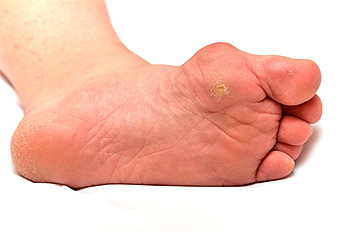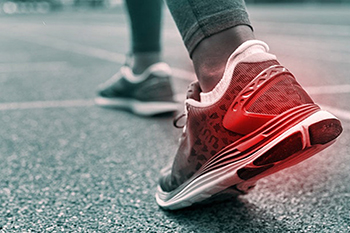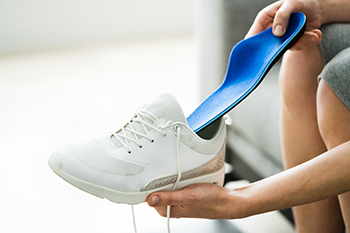3320 North Buffalo Drive
Suite 107
Las Vegas, NV 89129

Peripheral neuropathy is a condition frequently associated with diabetes and is caused by damage to the nerves that send messages to the lower legs and feet. Symptoms include numbness, tingling, and a loss of sensation in the feet. Peripheral neuropathy can be caused by sustained high levels of sugar in the blood, from a viral infection, or by excessive smoking and drinking. In some cases, the effects of peripheral neuropathy can be reduced by treating the underlying condition. But in many cases, especially among diabetics, an unattended sore on the foot can become infected or develop into an ulcer. This complication is dangerous in that an ulcerated sore can turn into gangrene. If not treated, a foot ulcer that develops into gangrene may result in amputation. Peripheral neuropathy can also cause blood circulation problems as well as changes to heart rhythm. The main way to deal with peripheral neuropathy as it affects the feet is to inspect them carefully each day for cuts, sores, blisters, or any other abnormality that could become infected. For more information, it is suggested that you make an appointment with a podiatrist.
Neuropathy
Neuropathy can be a potentially serious condition, especially if it is left undiagnosed. If you have any concerns that you may be experiencing nerve loss in your feet, consult with one of our podiatrists from Summerlin Foot & Ankle. Our doctors will assess your condition and provide you with quality foot and ankle treatment for neuropathy.
What Is Neuropathy?
Neuropathy is a condition that leads to damage to the nerves in the body. Peripheral neuropathy, or neuropathy that affects your peripheral nervous system, usually occurs in the feet. Neuropathy can be triggered by a number of different causes. Such causes include diabetes, infections, cancers, disorders, and toxic substances.
Symptoms of Neuropathy Include:
Those with diabetes are at serious risk due to being unable to feel an ulcer on their feet. Diabetics usually also suffer from poor blood circulation. This can lead to the wound not healing, infections occurring, and the limb may have to be amputated.
Treatment
To treat neuropathy in the foot, podiatrists will first diagnose the cause of the neuropathy. Figuring out the underlying cause of the neuropathy will allow the podiatrist to prescribe the best treatment, whether it be caused by diabetes, toxic substance exposure, infection, etc. If the nerve has not died, then it’s possible that sensation may be able to return to the foot.
Pain medication may be issued for pain. Electrical nerve stimulation can be used to stimulate nerves. If the neuropathy is caused from pressure on the nerves, then surgery may be necessary.
If you have any questions, please feel free to contact our office located in Las Vegas, NV . We offer the newest diagnostic and treatment technologies for all your foot care needs.

Corns are areas of hardened skin that usually appear on the top of the feet and around the toes. They form on pressure points or around bony areas and usually come from shoes that are too tight and cause pressure or friction on the feet. Corns can become irritated and painful. While it may seem counterintuitive, corns develop to protect the feet from further damage. Beyond ill-fitting shoes, corns can develop from gait abnormalities or structural issues with the feet. Things that can help relieve the pressure of this affliction are using corn pads, getting custom orthotics made, and wearing better-fitting shoes. Soaking the feet in warm water, rubbing corns gently with a pumice stone, and moisturizing the skin can also help. Patience is needed as it can take time for corns to shrink and go away. If you have corns that are larger or worsen, it is suggested that you see a podiatrist for further treatment.
If you have any concerns regarding your feet and ankles, contact one of our podiatrists of Summerlin Foot & Ankle. Our doctors will treat your foot and ankle needs.
Corns: What Are They? and How Do You Get Rid of Them?
Corns can be described as areas of the skin that have thickened to the point of becoming painful or irritating. They are often layers and layers of the skin that have become dry and rough, and are normally smaller than calluses.
Ways to Prevent Corns
There are many ways to get rid of painful corns such as wearing:
Treating Corns
Treatment of corns involves removing the dead skin that has built up in the specific area of the foot. Consult with Our doctors to determine the best treatment option for your case of corns.
If you have any questions please feel free to contact our office located in Las Vegas, NV . We offer the newest diagnostic and treatment technologies for all your foot and ankle needs.

The available array of running shoes is a positive thing but can be daunting. It is not easy to determine the right pair of running shoes for your feet and your needs. The shoes must fit well and be comfortable. Running shoes have different purposes and are designed to fit the foot of the runner in specific ways. Slight variations can impact one's running experience. Trying them on later in the day, with socks and insoles that will be worn while running, can help ensure a proper fit. Everything above the sole of the running shoe should lay smooth and not bind, chafe, or bunch anywhere. The heel should not slip or irritate the back of the Achilles tendon but should allow for comfortable ankle movement. The way the shoes lace and support the arch should feel secure and allow for the natural doming of the arch while running. The toe box should be wide enough to allow the toes to spread naturally and should not rub against them in any way. The soles of the running shoes should match the running surface and be made of materials that provide traction, stability, and durability, without adding weight or stiffness. The proper shoes should flex or roll in the way the foot moves, be cushioned to personal comfort, and be of a height that feels right and reduces stress on weak parts of the feet. If overpronation is a problem, the shoes purchased should have more stabilization features. If you have questions about the right running shoes for you, it is suggested that you consult with a podiatrist for help in this area.
If you are a runner, wearing the right running shoe is essential. For more information, contact one of our podiatrists from Summerlin Foot & Ankle. Our doctors can provide the care you need to keep you pain-free and on your feet.
Choosing the Right Running Shoe for Your Foot Type
To increase performance and avoid the risk of injury, it is important to choose the right running shoe based on your foot type. The general design of running shoes revolves around pronation, which is how the ankle rolls from outside to inside when the foot strikes the ground.
If you have any questions please feel free to contact our office located in Las Vegas, NV . We offer the newest diagnostic and treatment technologies for all your foot and ankle needs.

Anyone with plantar fasciitis knows how much pain it can cause, and one of the ways to ease that pain is by using shoe inserts, or orthotics. The plantar fascia is a band of tissue that runs along the sole of the foot. When this tissue is torn from overuse, it becomes inflamed and a stabbing pain is mostly felt in the heel and arch. One of the major causes of plantar fasciitis is improper footwear. It is especially common in runners and women who frequently wear high heels. Shoes should have the proper arch support as well as ample cushioning to absorb shock. Special orthotics may be helpful in this regard, particularly in people with flat feet, high arches, or other biomechanical foot conditions. In these cases, ready-made shoe inserts may not be able to solve the problem. Custom orthotics made by a podiatrist can be exceedingly helpful because they are constructed to fit the contours of your feet perfectly and correct the problem areas. For more information, it is suggested that you make an appointment with a podiatrist for an exam.
If you are having discomfort in your feet and would like to try orthotics, contact one of our podiatrists from Summerlin Foot & Ankle. Our doctors can provide the care you need to keep you pain-free and on your feet.
What Are Orthotics?
Orthotics are inserts you can place into your shoes to help with a variety of foot problems such as flat feet or foot pain. Orthotics provide relief and comfort for minor foot and heel pain but can’t correct serious biomechanical problems in your feet.
Over-the-Counter Inserts
Orthotics come in a wide variety of over-the-counter inserts that are used to treat foot pain, heel pain, and minor problems. For example, arch supports can be inserted into your shoes to help correct overarched or flat feet, while gel insoles are often used because they provide comfort and relief from foot and heel pain by alleviating pressure.
Prescription Orthotics
If over-the-counter inserts don’t work for you or if you have a more severe foot concern, it is possible to have your podiatrist prescribe custom orthotics. These high-quality inserts are designed to treat problems such as abnormal motion, plantar fasciitis, and severe forms of heel pain. They can even be used to help patients suffering from diabetes by treating foot ulcers and painful calluses and are usually molded to your feet individually, which allows them to provide full support and comfort.
If you are experiencing minor to severe foot or heel pain, it’s recommended to speak with your podiatrist about the possibilities of using orthotics. A podiatrist can determine which type of orthotic is right for you and allow you to take the first steps towards being pain-free.
If you have any questions please contact our office located in Las Vegas, NV . We offer the newest diagnostic and treatment technologies for all your foot and ankle needs.